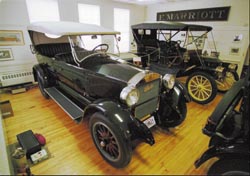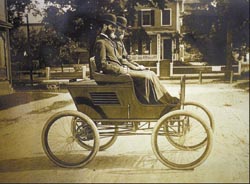This
car climbed Mt. Washington
Remembering the Maine-built
Stanley Steamer.
by Glenn Adams
Associated Press
Copyright © 1998 Associated Press
This story first appeared in the Portland Press
Herald on December 28, 1998.
 The Stanley Museum in Kingfield
honors the enterprising twins, F.E. and F.O., and is housed in a
converted wooden high school they designed. It includes restored
Stanley Steamers and family treasures such as violins, relics from
their photographic dry-plate business and a Stanley Motor Carriage
Co. clock. The Stanley Museum in Kingfield
honors the enterprising twins, F.E. and F.O., and is housed in a
converted wooden high school they designed. It includes restored
Stanley Steamers and family treasures such as violins, relics from
their photographic dry-plate business and a Stanley Motor Carriage
Co. clock.
AP photo
|
KINGFIELD - This western Maine town may be best known for downhill
skiing, but it was an uphill climb a century ago that brought it a puff
of glory.
Sugarloaf, the state's tallest ski mountain, is in the neighboring
town. But Kingfield has its own claim to fame: It's the birthplace of
F.E. and F.O. Stanley, the identical twins who gave us the quirky
automobile named for them.
And 1999 will be an important year for aficionados.
The new year will mark the 100th anniversary of one of their early
models shaking and panting its way over a bumpy road and past sheer
dropoffs to the top of 6,293-foot Mount Washington in New Hampshire.
Owners of the remaining Stanley Steamers are gearing up to re-create
the event of Aug. 31, 1899, that marked the first horseless carriage to
climb to the top of New England's highest peak.
Nearly 600 people have been notified, and steamers are expected from
as far away as California and England.
"They are a special ilk," said the great-granddaughter of F.E., Sarah
Walker Stanley, who will bring an 1899 Locomobile to the festivities.
"They run their cars, they know the technology, they know the history."
The hubbub is also expected to draw attention to Kingfield's modest
but fascinating Stanley Museum, which is housed in a yellow-and-white
converted wooden high school that was designed by the Stanley brothers
and was later saved from demolition by town fathers.
The Georgian structure is home to a few restored Stanley Steamers and
a growing collection of family treasures.

At right: Kingfield natives F.E. and F.O. Stanley show an early
Stanley Steamer. AP photo
There are finished and unfinished violins the twins built, pictures
made with an airbrush F.E. invented, relics from their photographic
dry-plate business and a clock from the Stanley Motor Carriage Co.
A recent addition to the museum is an early buggy-styled wooden
Locomobile equipped with a steering "tiller," white tires and, most
curiously, a socket to hold a horsewhip.
The museum is a monument to an age of bare-knuckled capitalism and
engineering creativity that ushered in modern America, as presented by
the Stanleys, Edisons and Wrights of the day.
Francis Edgar Stanley and Freelan Oscar Stanley, the second and third
of six siblings, showed unusual intelligence and ambition early.
F.E., an award-winning portrait artist, patented the airbrush in
1876. The brothers became partners in the Stanley Dry Plate Co. in 1884
and patented a dry-plate coating machine that revolutionized the
process.
Eastman Kodak bought the Stanleys' dry-plate company in 1904, long
after F.E. had begun tinkering with motorized carriages, using steam as
the energy source. His wife's inability to ride a bicycle was said to
have spurred him on.
F.E.'s machine was demonstrated in 1898 at Charles River Park
Velodrome in Cambridge, Mass., where it set a world record of 27 mph.
The brothers worked in a converted bicycle shop in Watertown, Mass.,
filling 100 orders in 1898-99 before selling out to a magazine publisher
who rechristened the early Stanley Steamers the Locomobile. Later, they
went back into the business.
By the time the Stanley Steamer hissed into the sunset in 1924,
around 11,000 of them had been built.
In addition to being innovators, the brothers were skilled marketers.
F.O. took center stage in the 1899 publicity stunt in which he and his
wife Flora drove the chugging steamer to Mount Washington's summit.
Later, he gave President William McKinley the first ride a president had
ever received in a motorized carriage.
Powerful, speedy and exquisitely simple, the Steamers were powered by
pressure built up in a 23-inch, piano wire-wrapped boiler that drove
pistons in much the same fashion as a locomotive engine.
There was no transmission, and it used water instead of gasoline. But
that's where practicality ended.
The removal of roadside water troughs in 1914 because of an epidemic
of hoof-and-mouth disease is cited as one reason for the demise of the
Steamer, whose thirst needed to be slaked regularly.
The steam-powered carriage business ran out of steam six years after
F.E. was killed when he crashed a steamer in 1918. F.O. turned his
attention to a violin-making business before his death in 1940 in Estes
Park, Colo., site of a hotel he built and another Stanley Steamer
museum. The Steamers were known for their "coffin nose" appearance, and
early models required some level of expertise to manage all of the
valves and knobs to keep them chugging smoothly.
Later models were more refined. And some were even luxurious: A 1916
touring car gracing the Kingfield museum is a deep, midnight blue, with
soft top and leather interior. Although they have been relegated to the
oddball file of automotive relics, m Many Steamers remain operable.
However, Sara Walker Stanley said the steam-powered carriage that she
and her husband are towing from Chatham, N.J., won't be headed up the
windy road to the top of Mount Washington.
"It just doesn't have it any more," she said. "For this century-old
car, it would be the end."
Have a question or comment? Send e-mail to wheels@mainetoday.com.